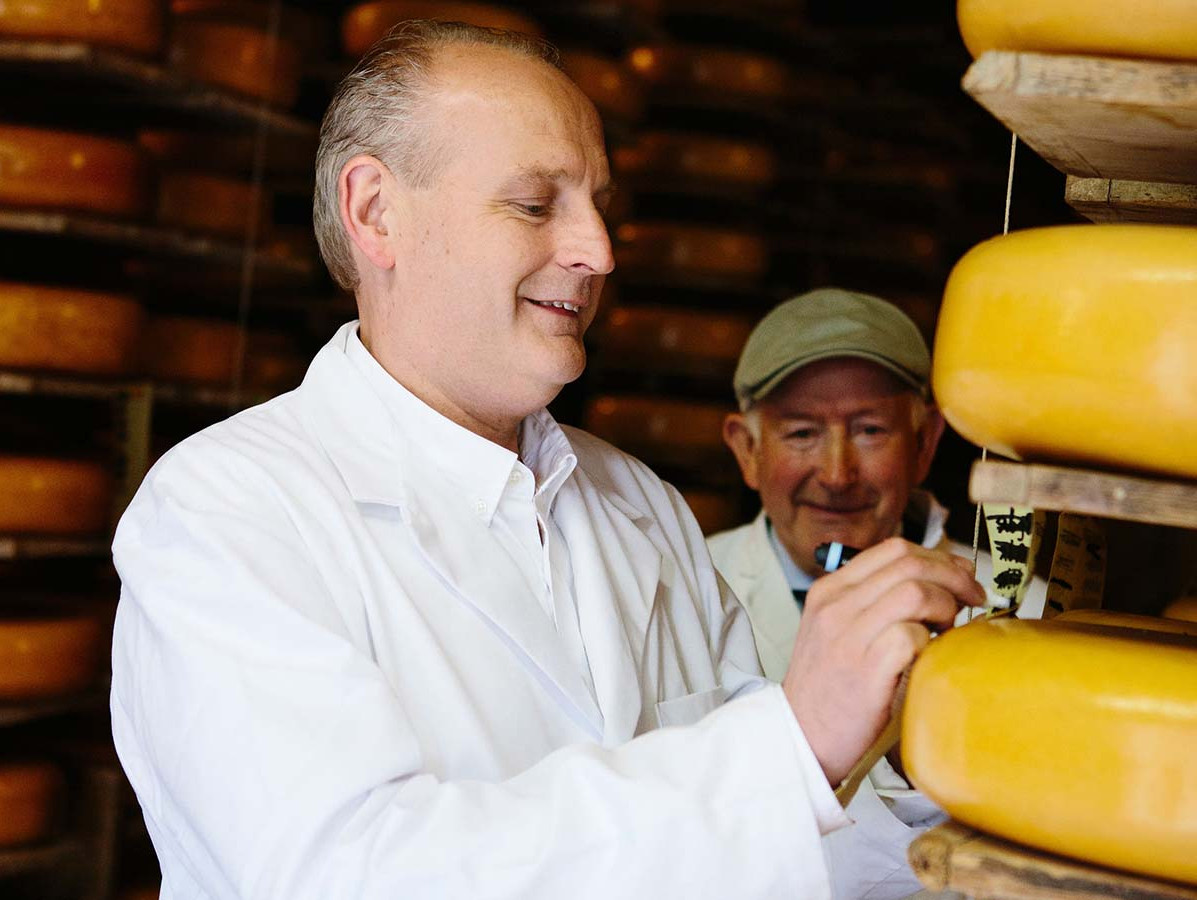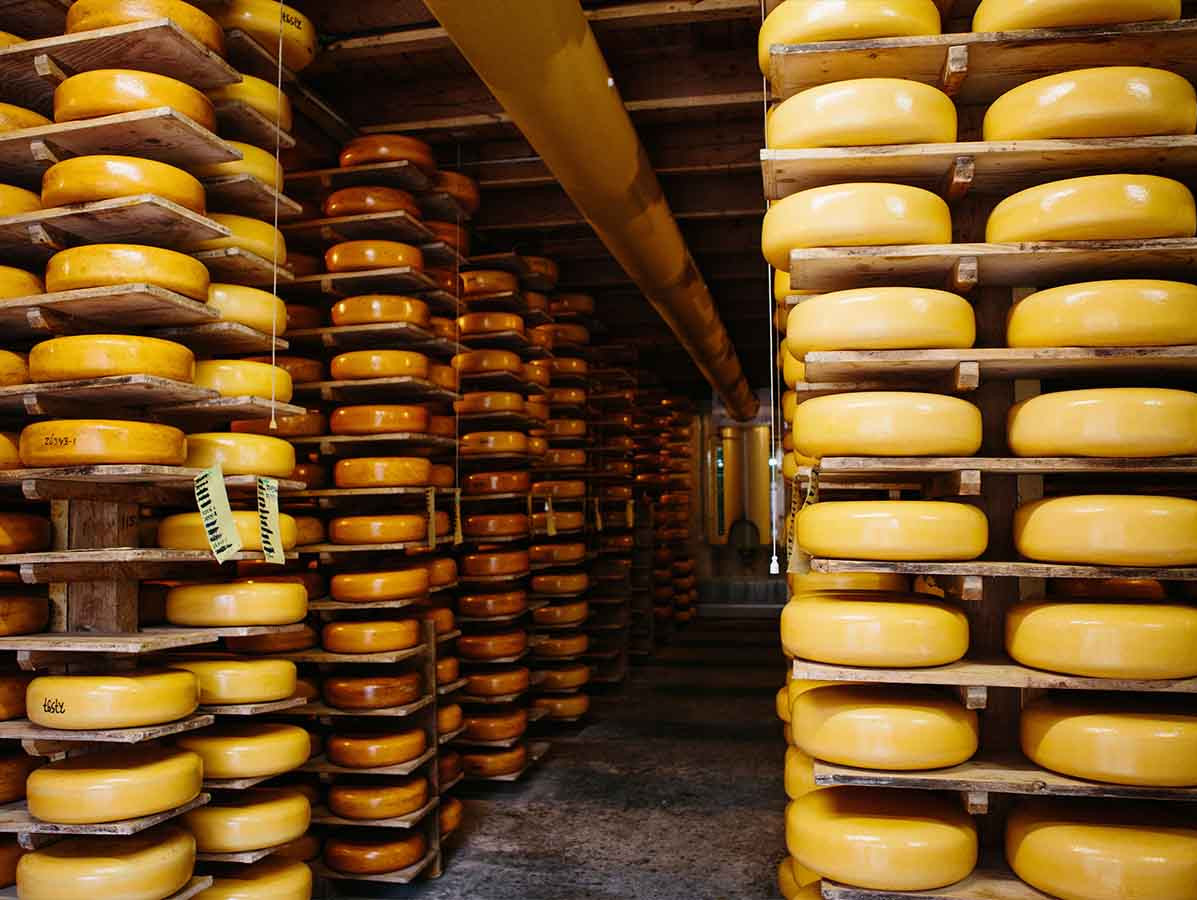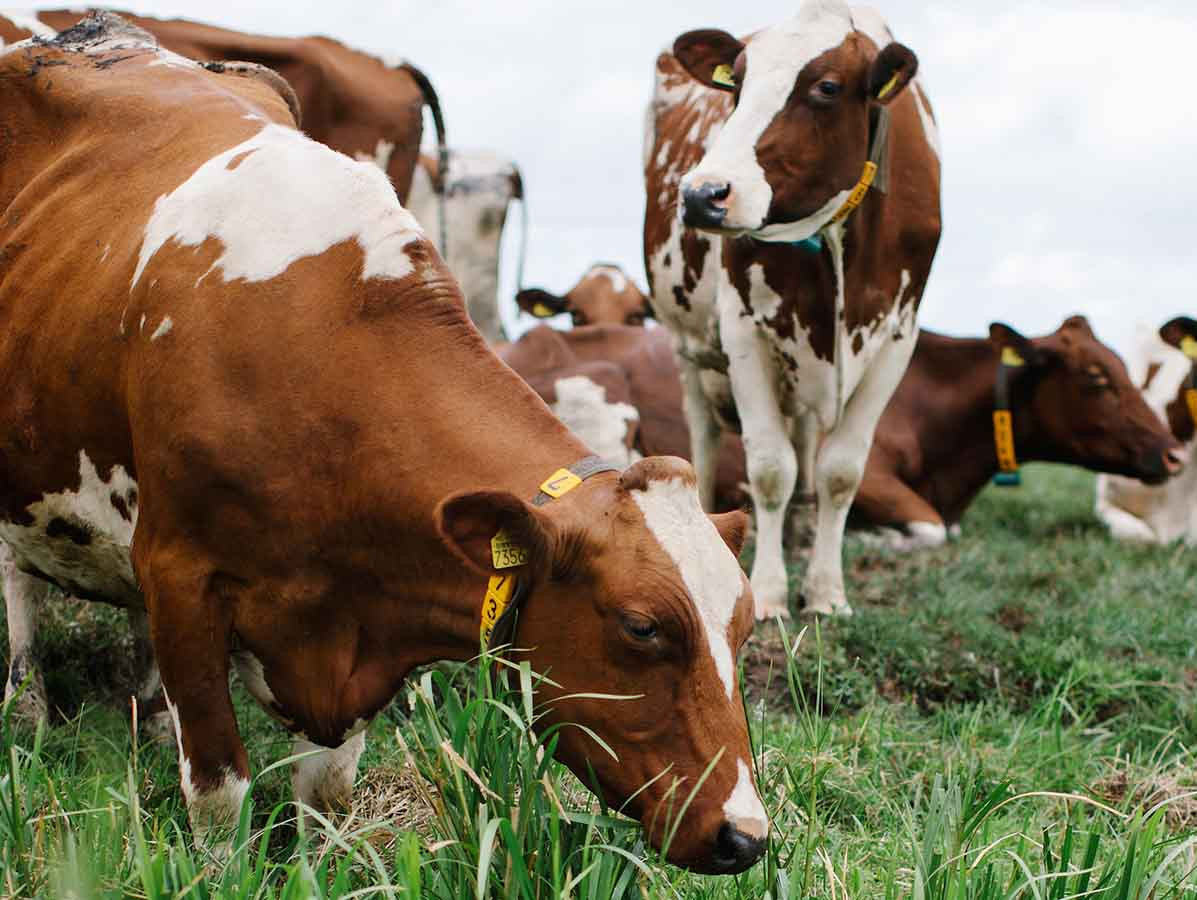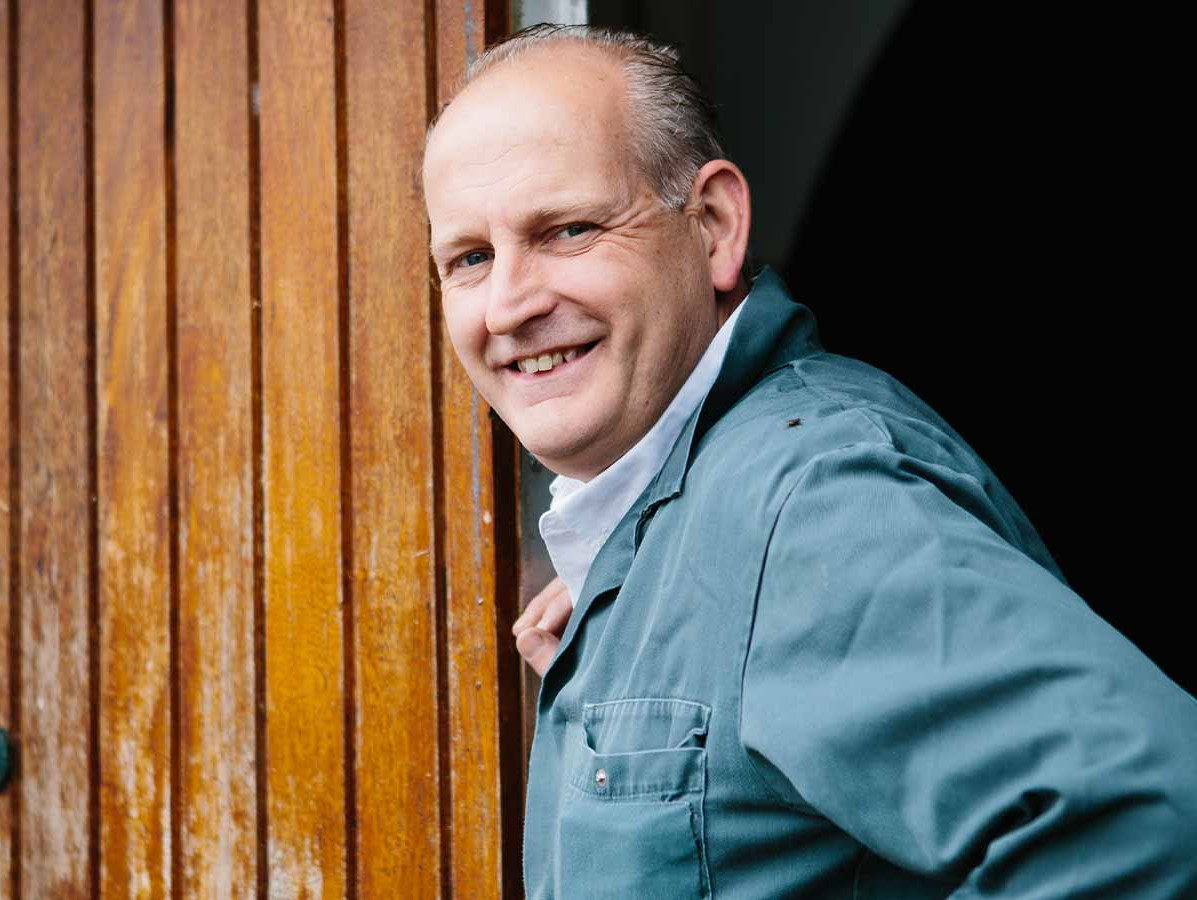
Evert Fokker is the only farmer in the Netherlands who is also a cheese trader (and vice versa). From the milk of "his girls," almost five hundred ‘Roodbonter’ cows of the MRIJ breed, a delicious protein-rich cheese is made: "the Roodbonter."
We walk through the air-conditioned warehouse of cheese trader Evert, and our noses are filled with the spicy scent of cheese. This is the heart of the Korver cheese trade. As far as the eye can see, the round yellow cheeses lie on the shelves of the racks, up to the ceiling. "These cheeses are all turned mechanically," Evert explains. "In the natural warehouse, where our own Roodbonter cheeses are stored, this is done manually. These cheeses bear the National mark 'Cheese from own farmer' and the label EFTB (Evert Fokker in Bodegraven, ed.)." Apart from the cheese trade in Bodegraven, he has a farm in Zwammerdam; with dairy cows and some pigs.
Evert's Roodbonter cows are of the Meuse-Rhine-Issel (MRIJ) breed. They produce less milk than the well-known black and white Holstein Frysian dairy cows, but the milk contains more protein and tastes creamier. "I wanted to introduce a distinctive product to the market with our milk," Evert shares. "But I didn't know anything about concepts and brands. That's why I talked to CONO Cheesemakers. They know better than anyone how to make good cheese AND how to position a brand in the market. Because CONO wanted to be sure of our claim - Roodbonter milk is creamier and richer in protein - we had it tested: in a laboratory, but also by 'milk sommelier' Bas de Groot. From both sides, the confirmation came that the milk from our grass-fed MRIJ cattle is higher in fat and protein. Not only the breed but also the feeding regime affects the taste. 'The taste of these grass-fed animals is clearly different from the maize-fed Holstein Frysian. More fruity, I would call it,' the milk sommelier once told Delicious Magazine in an interview."

"In hindsight, had I known how much time, money, and effort it would take to launch our own brand, I might never have started," Evert admits honestly. "But now it stands. And we're growing!" According to him, the success of the brand is partly because it fits the current zeitgeist. "Consumers want to know where the products they eat come from and who made them. We make 'cheese with a face'," he says proudly. "Our cheese is rich in protein and has a unique taste. And it's sustainable. Roodbonter cows live longer than the Holstein-Frysian; namely 8 years compared to an average of 4. They drink water from our own well and eat our Zwammerdam grass. Furthermore, they are not given preventive antibiotics."
Roodbonter cheese is not on supermarket shelves; consumers have to go specifically to the fresh food specialist or hospitality industry. To best meet to customer needs, Evert conducted consumer research. "It emerged that the 'mild' and 'spicy' varieties would be the best sellers; that's why consumers go to the specialty store. We started with that, but practice proved differently. Specifically, the demand for our Roodbonter grass cheese, which we call 'Jonkie' (Youngest, ed.), is the highest. I think this is due to its excellent melting properties. The cheese is therefore very suitable for grilled cheese sandwiches and nachos with cheese from the oven; dishes that are popular in the hospitality industry. We even have a fondue recipe for this cheese variant."

From the air-conditioned cheese storage, we drive to the farm in Zwammerdam. Evert has been roaming around here since he was a child. "My father, Jan Fokker, once chose the Roodbonter breed, purely because he loved the color," Evert laughs. "Back then, we had about 80 cows; now there are almost 500." Every morning, the alarm clock in the living house goes off precisely at 03:10, an hour later in winter. Evert starts his working day in his overalls, milking the cows. The farm produces around 2.5 million liters of milk annually. After that, he exchanges his overalls for a suit and heads to the cheese trade office in Bodegraven or visits existing and potential new customers. Now, in the middle of the day, it is quiet on the farm. The milk carousel is empty. "Twice in my career, we had a power outage here. The cows could not be milked on time," Evert says, clearly not the type of man you can easily fluster. "But THEN I was stressed!"
Part of the current herd is outside in the meadow, another part is in the barn; they alternate inside and outside due to the heat. All the way to the right, separate from 'the ladies', are two Roodbonter bulls. "Our cows are bred naturally," Evert explains. On the other side of the barn, meanwhile, a cow rubs her backside against a brush. The other animals are lying or standing relaxed, ruminating or grazing on the silage grass. They curiously look up at the visitors in their barn. Evert knows all his cows and makes it a sport to recognize them one by one by number during milking. "For the cheese's good quality, it is essential to make the milking as hygienic as possible," he explains. To minimize the risk of, for example, the butyric acid bacteria feared by cheese farmers, he adheres to a strict stable, pasture, and cow hygiene protocol. This means that teats are cleaned before milking, milking is done with gloves on, the animals' legs and flanks are washed thoroughly at regular intervals, and the stalls are cleaned daily (mechanically).

Evert is clearly proud of the family business. His father, now in his 80s, is still regularly on the premises to help. His wife, Nelleke, a sister, and other family members also help. And the fourth generation? "They occasionally help out," says Evert. "I sometimes take my children, we have five, to international fairs; just because it's fun. I hope one of them will want to take over the business, but we're not there yet. They are still young, the oldest is only 19. The youngest, 8 years old, is a real farmer's girl; she loves the animals. I think there is a lot of potential for our cheese on the export market. For that project to succeed, you have to speak your languages well. My children can do that, so there are a lot of opportunities for them in that area. But they can discover for themselves and decide what they would like to do later."
"What will the future bring? Every year we make a forecast for the coming year. And every year something happens. It remains a matter of guessing," Evert thinks. "For example, I was quite worried about nitrogen load and peak loads. I am located near the Nieuwkoopse Plassen, a Natura 2000 area. After entering all the data, the calculations showed that I am NOT a peak loader. So, we can just continue. That was a relief." And further? He remains down-to-earth. "Prices have gone up, but not just ours. Factory cheese and our cheese have come closer in price. This makes the choice for ours even easier for consumers." In the meantime, he is anything but idle. Product development continues. During the last Vakbeurs Foodspecialiteiten in Houten, in October 2022, Evert launched the 'Roodbon-bon-ter'; a real blockbuster. The brightly colored white chocolate bonbons, filled with soft old cheese and a dab of apple syrup, are made by a pâtissier and sell well in the many tourist shops in and around Amsterdam. Just like the spicy and creamy cheese salad according to his own recipe. "Great with the traditional bread basket in restaurants; instead of - or alongside - the well-known herb butter," says Evert. He is already working on something new: "But that's still a secret," says the cheese trader/farmer with a twinkle in his eyes. "I enjoy being creative," Evert concludes. "Anything can happen."
Source: Vakblad Voedingsindustrie 2023